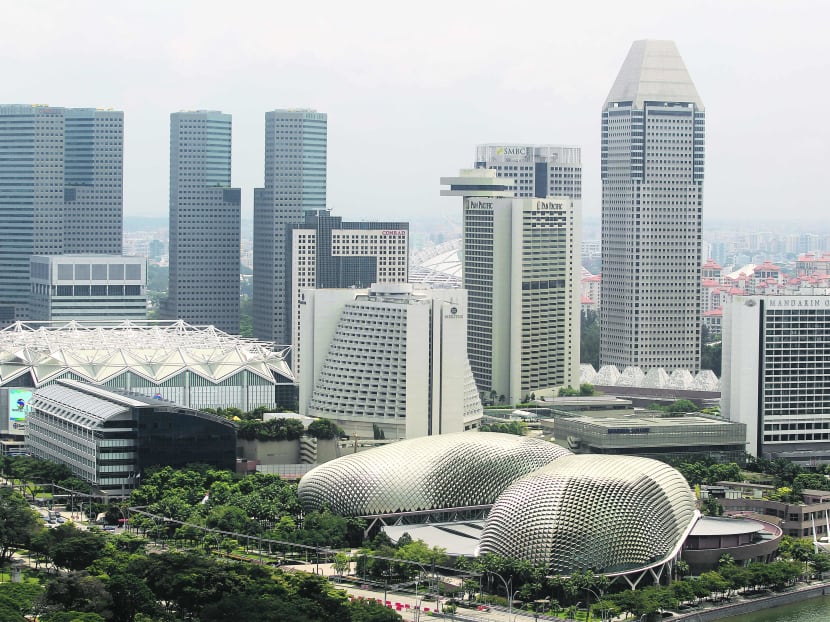BCA to study how to equip older buildings to deal with haze
SINGAPORE — When the Republic went through its worst spell of haze in June this year, some building owners were left helpless as murky clouds of pollutants formed in their lobbies.
SINGAPORE — When the Republic went through its worst spell of haze in June this year, some building owners were left helpless as murky clouds of pollutants formed in their lobbies.
IAQ Consultants, which provides indoor air quality diagnostic and consultancy services, tested the buildings of 12 to 15 clients then and found that none of them met standards specified in Singapore’s code of practice for indoor air quality of air-conditioned buildings, said its General Manager Emma Precious.
That could all change in the future, as the Building and Construction Authority (BCA) is studying if older buildings can be better equipped to deal with haze situations, should they occur again.
In particular, it wants to find out whether upgrading their air filtration systems is a feasible idea, what technical challenges the work could entail and how much it would cost, including for subsequent maintenance and the differences in energy consumption.
It called a tender earlier this month to study 10 existing non-residential buildings — including hotels, malls and offices — that are more than 10 years old.
Asked why it was commissioning the study and whether it was because of concern about the impact of the haze on building occupants earlier this year, the BCA would only say that indoor environment quality is one of the focus areas of its upcoming third Green Building Masterplan.
It mentioned a “haze situation” in the tender “so that tenderers can take such situations into account in the feasibility study”, a spokesperson said.
It is not known how many buildings here are equipped with air filters of the Minimum Efficiency Reporting Value 13 (MERV 13) standard stated in the tender, but those developed since 2009 are required to have secondary air filters that meet the mark.
MERV 13-rated filters should ideally filter out more than 90 per cent of particles 1 to 3 microns in size.
The current code of practice for indoor air quality of air-conditioned buildings specifies thresholds for potential indoor air contaminants — for instance, that particulates up to 10 microns in size should not exceed 50 micrograms per cubic metre.
Buildings with the BCA’s Green Mark certification are likely to have more efficient air filters. Nearly 1,700 buildings — which make up one-fifth of the total gross floor area here — bear the Green Mark, said the spokesperson.
Although Singapore’s buildings are probably better equipped than those in Malaysia or Indonesia to filter out pollutants, most older buildings here that he has encountered have less efficient air filter systems rated MERV 5 to 8, said Mr Nigel Grier, Chief Executive of BE Integrative Design, a specialist engineering, design and project management firm. “A lot more can be done,” he said.
Experts noted that cost could be an obstacle to filtration system upgrades.
More efficient air distribution systems – of which filters are a component – may consume 12 per cent more energy than less efficient ones, said Mr Joseph Toh, Chairman of the Institution of Engineers’ mechanical and electrical engineering technical committee. It costs about S$8/sq m of gross floor area to upgrade to an MERV13 system, he added.
Even among air filters with the same efficiency, costs can vary by up to 10 times, noted Mr Grier. But he pointed out that higher-quality, higher-level filters generally mean lower system costs over their lifetime.
It is “critical” for businesses to ensure high indoor air quality for their staff, he said. “Business must go on (even during the haze) and people need to be able to work in a comfortable, healthy environment.”
Mr Toh also added that “a healthy building may be able to command higher rentals and attract more people to occupy it”.
em>Correction at 6.45pm on Oct 31, 2013: The original article quoted Mr Joseph Toh as saying more efficient air filters may cost 12 per cent more than less efficient ones. This is incorrect. What he said was that more efficient air distribution systems – of which filters are a component – may consume 12 per cent more energy than less efficient ones.







